Using advanced discounting to expand your affiliate promo code horizons
Written by Guest Contributor on 18 minute read
Excerpted from The Ultimate Promo Code Guide: Chris Giddins shares tips for implementing an advanced affiliate promo code strategy.
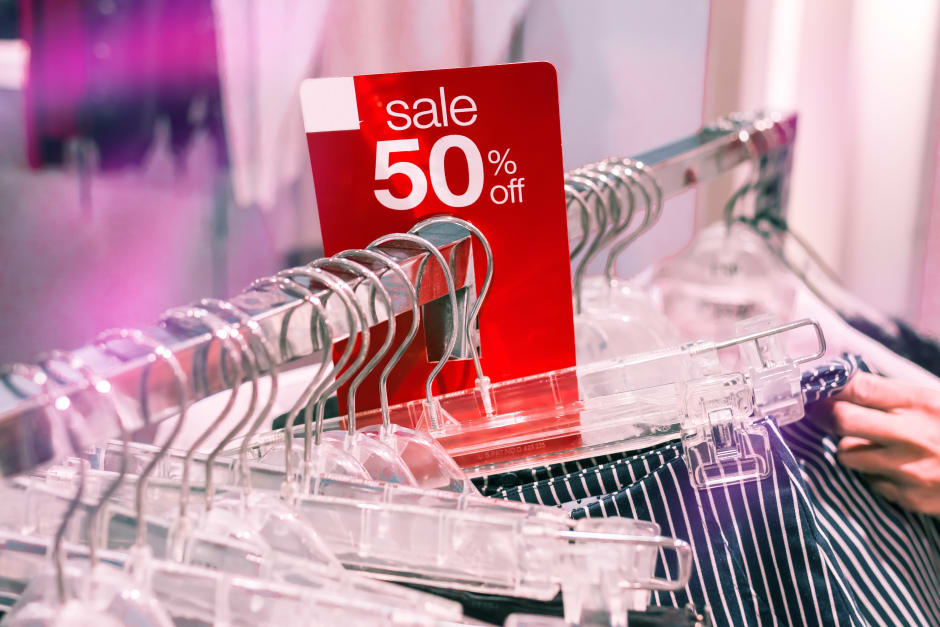
You don’t want a bog-standard affiliate promo code strategy. Nor do you want to simply side-step the pitfalls of coupon campaigns. E-commerce is an increasingly competitive space. Every day, new brands bring their stores online, and e-commerce leaders constantly update and improve their strategies.
If you’re going to stand out online, you need creative strategies to help. Clever applications of promo codes are a great way to do that. However, the key to getting creative is investing in the kind of technology that will really allow you to cut loose.
To deploy flexible affiliate promo code strategies, you need to personalize. You also need to make sure that only the intended audience can use your personalized promo codes, meaning you need single-use, unique and truly engaging promo codes. Personalization also requires automation. If you can’t deliver unique promo codes using automated technology, your codes will be misused and you won't have the time or resources to control your system.
Creative ideas for unique AFFILIATE promo code campaigns:
Target shopping cart abandonment
Shopping cart abandonment is a big problem online. Average cart abandonment rates are There are certainly variations between industries, with the travel industry nearly topping the charts. However, there isn’t a business or market sector that could not improve sales by decreasing this figure. It’s estimated that abandonment results in $18 billion of missed revenue across the industry.
The main reason that people state for abandoning carts is simply being unready to buy. Second on that list, however, accounting for about 25% of total abandonments, is being unsatisfied with the total end price.
The creative use of affiliate promo codes can help claw back some of the opportunities missed in shopping cart abandonment — increasing total revenue, if also reducing margins. Finally, you might be able to grab the attention of the estimated 40% of shoppers who place items in their cart without any real intention of making a purchase.
Ultimately, any attempt to reduce abandonment statistics requires communicating with consumers. Customers are much more likely to read your messages if they are highlighted with a personalized promotion.
How unique codes deliver
Preventing code misuse is critical to a successful promotional campaign aimed at stopping shopping cart abandonment. Because of the focused objective, generic codes are dangerous to use. If your code leaks, it will remove the exclusivity of the code (diminishing its impact), and damage your overall revenue without gaining the traction you need against this specific metric.
How to deliver abandonment preventing promo codes
The most straightforward way to follow up with customers who have abandoned items in a cart is to send them an email. Conducting promo code tests is important; you can experiment with on-page reminders — targeting shoppers the next time they log in, or before they leave the page. This is limited, however, because it might be a while before they log back in, and you don’t truly know that an ‘abandonment’ has occurred until they are gone.
The biggest challenge with sending emails is getting an email address. Your campaigns that are targeted at preventing shopping cart abandonment will be limited to individuals logged in as existing customers. Make sure to ask people for their email when creating an account.
What we recommend
The most effective way to reduce shopping cart abandonment is a combined tactic of emailed promo codes and on-site promotional offerings.
Unique code generators can help you do both. You can set up personalized emails that will be sent in response to abandoned carts, as well as personalized messages that will appear the next time that shopper visits your site. Lastly, you can consider creating personalized messages that remind people about their shopping cart while they are attempting to close a page.
Remember, when making an offer, how you phrase the discount is important. Free shipping is a great starting point. You should also consider including authentic urgency statements — “only three left in stock,” “limited time offer on products” etc. This is a great example:
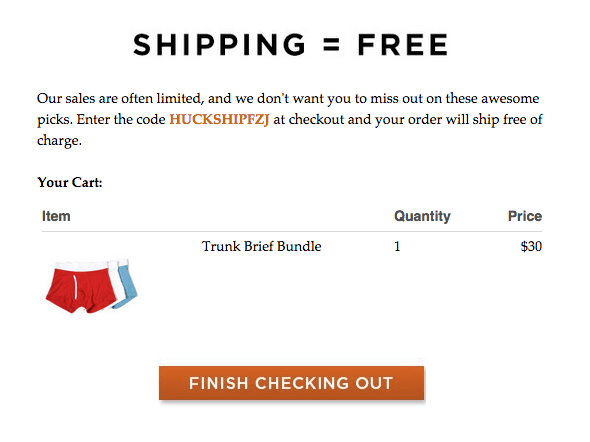
We also suggest incorporating some of the other strategies outlined below — including diminishing discounts, mystery discounts and time-sensitive discounts. Always make sure that you are collecting data, A/B testing outcomes and continually honing your plan.
Pitfalls of this plan
The biggest issue when exploring personalized discount code ideas to help limit shopping cart abandonment is training your audience to abandon their carts in anticipation of discount offerings. One way to avoid this is to not offer discounts every time. If your emails that remind shoppers about cart abandonment only occasionally offer promotions, it will be far less likely that your core audience is conditioned to abandon their carts as ‘par for the course.’
You also need to consider the best time to make contact. Your plan will do no good if your emails are never opened or never seen in the first place. There is actually a lot of division over the best time to send a promotional email.
Some marketers strongly believe that sending an abandonment email within 20 minutes gets the best results. Others believe waiting 24 hours and sticking to evening and weekends is key. Your audience is likely to play a role here, and this is one of several reasons that you should conduct A/B tests.
You might also consider the value of the cart. Large purchases often take longer to consider. Maybe wait to follow up with larger purchases. On the reverse side, consider the margin for the product. You can offer greater discounts on high-margin products while still turning a profit. Another approach is to promote a ‘stretch and save’ discount where the current basket value is stretched to a bigger value with the use of a discount.
Engage with influencers
Influencer marketing is considered a ‘standard’ promo code strategy. However, unique codes make engagement with influencers easier and safer. Influencer marketing is such a growth sector within digital marketing that we need to go into it in greater detail.
Why influencers are more important than you think
Almost half of the global population is now an active social media user. What’s more, word of mouth works. 90% of consumers trust peer recommendations, while only 33% trust ads. 32% of internet users now use some form of ad blocker, meaning fewer people even see those traditional ads… that they already don’t trust. On the other hand, influencers seem to get grouped together with ‘peer recommendations.’ 40% of millennials say that their favorite YouTube creators understand them better than their own friends.
Most brands will benefit from advertising through social media and online influencers. The proliferation of niche creators has developed a mass web of ‘micro-influencers,’ all of whom can be tapped into to sell your product — if the right incentives can be applied.
How unique codes deliver
Affiliate promo codes play a valuable role in engaging with influencers. Influencers need the ability to provide real value to their audiences. You need the ability to track the results of particular influencer campaigns.
Unique promo codes add to the exclusivity of a promo campaign, and make the results of that campaign easier to track — all while removing the ever-present risk of code misuse. You can freely engage with as many influencers as you want and offer each of them special perks and bonuses tailored to the audience segments they are helping you access.
You should think about the various messaging strategies we have discussed to this point, and incorporate those mentioned later on. Fundamentally, however, a promo code generator will make this easy, allowing you to broadly hand over the messaging challenges to the affiliate. The big challenge for you is finding the right partners. To do that, you need to think about the audience you are trying to reach and the voices they value.
A common challenge with using unique codes with influencers is one of code issuance. It isn’t easy to issue ever-changing unique codes via the main social media platforms. This is where on-advertiser issuance is key. You can simply issue the unique code to the customer when they land on your website following a visit from the social influencer partner.
Give customers their own promo codes
Nearly half of all consumers discover a brand because someone that they personally know made a recommendation. This is the old-fashioned version of ‘influencer’ advertising — and it’s still the dominant force in customers’ lives. Referral marketing is big business.
Most successful brands figure out some way to engage with their audiences and incentivise happy customers to evangelise for their brands. Promo codes are a great way to do this.
How unique codes deliver
Unique promo codes make it easy to engage with existing customers and incentivize them to speak with people they know. You can generate unique one-time codes that can be offered to bring new customers on board. Because those codes are unique, they can be easily tracked, allowing you to offer rewards to shoppers based on how effective they are at spreading the word.
Uniquepromo codes are also critical to stop shoppers from simply using the promo codes you supply for themselves, encouraging them to hold out for better rewards that will come from bringing onboard new shoppers.
When you do this, make sure the offer, incentives and directions are clear. All of the same rules about what makes a good promo code apply to creating codes for both influencers and individual shoppers to use. This is one form of gamification — something we address in more detail later.
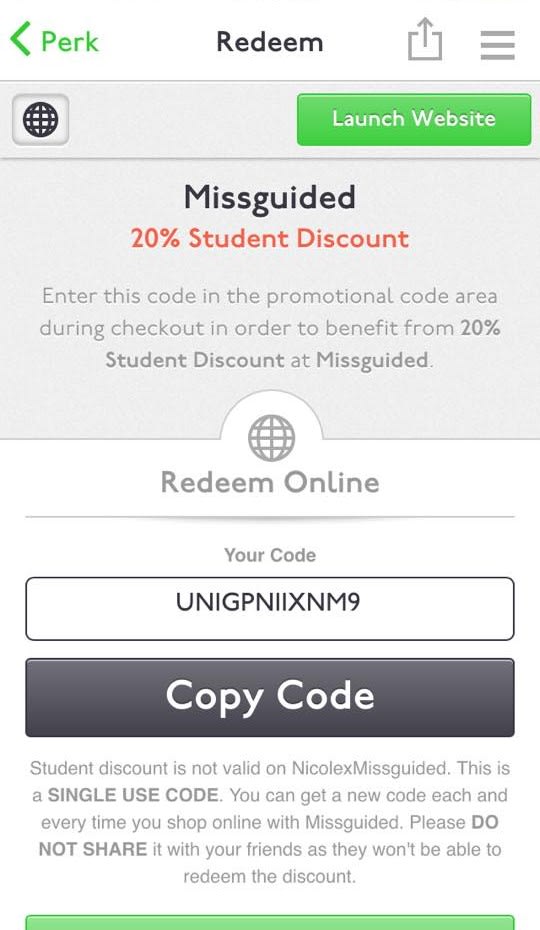
Creative messaging strategies for unique promo codes:
We have discussed the idea behind personalized discount codes and the value they bring. However, it’s hard to overstate the value of personalization when it comes to grabbing attention and driving engagement. You can achieve a degree of personalization with generic promo codes — but, you will always be limited. The codes you create won’t actually be personalized, just the messaging or call-to-action around the promotion.
Either way, creating personalized messaging requires investment in tools that will automate email campaigns. The same tools that will help you produce one-time codes can also help you automate and personalize your messaging without gobbling up all of your marketing resources.
Example: Use a customer’s shopping history to create tailored promo ads, offering discounts or free shipping based on products a shopper regularly buys — this will help create brand loyalty and be an offer that they are sure to appreciate.
You might also use a customer’s shopping history to learn something about them. For example, if they buy dog food, they almost certainly have a dog. You can then use that info to offer promotional deals of related products — grooming products, leashes, toys, etc. This is more effective than simply providing them with a store-wide discount because you are also simultaneously reminding them of a relevant product.
Surprise discounts
Sometimes it’s fun to surprise loyal customers with promos. This is another form of personalization that you should remember to access.
Focusing on broader events, like Black Friday promo code ideas for example, might yield decent results, but surprising customers with something personalized is far more enticing. One of the most common forms of a ‘surprise discount’ is the ‘birthday’ promo. Providing shoppers with a discount code on their birthday is not as new as it was a few years ago, but it’s still a way to grab attention and make loyal customers feel valued. Birthday promotion emails have an open rate 2.5x higher than standard email marketing promotions.
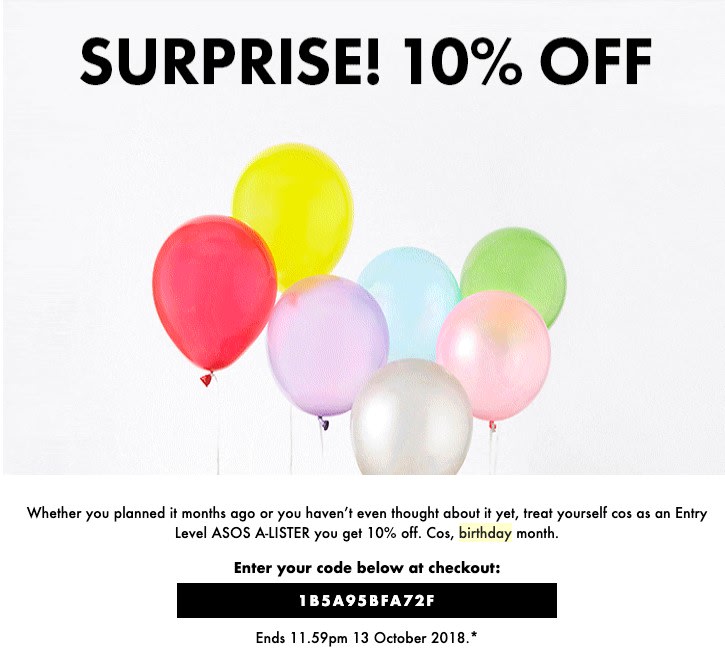
If you want to get more creative, you can branch out and use other events as a surprise discount trigger. For example, anniversaries based on the first time that customer made a purchase with you. Seasonal discounts, or discounts simply based on purchase pattern — see gamification for some more ideas about that.

However, as we mentioned previously, be careful about the kind of information you use to trigger a ‘surprise.’ If you are surprising a customer by letting them know you have ‘data mined’ their Facebook account, they might not be so happy. To be safe, make sure to only use information that the customer has supplied to you themselves to craft these kinds of campaigns.
Expiring promo codes — Scarcity marketing
If people think they have a limited time to act, they will be more likely to make an immediate decision. Rather than simply offering a user a discount, unique promo codes can be customized with any number of’ faders’ that will increase their likelihood of immediate use.
With multi-use codes, you can still put on expiry dates — this is a strategy we went over that will help you limit the impact of misused codes. With unique codes, you can use this differently. Your expiry period is not limited by the fact that you will have sent out this same code to different people at different times. With unique codes, you can make the expiry period as short as a few minutes.
Short expiry times are great for discounts that pop up on your website, enticing users that are taking too long to make a purchase, or stumble onto any number of other factors that can be used to trigger a promotion. These kinds of promo offerings are great for driving immediate conversions.
Diminishing discounts — Scarcity marketing 2.0
Similar to expiry times, you can deliver a sense of urgency to your promo campaign by creating a diminishing discount. For example, you could start a discount at 30%, and have that reduce by 5% every 5 minutes the discount has been displayed.
Like with expiring promo codes, using diminishing discounts as an in-website popup is a great for driving urgency. However, both can also be used in email marketing campaigns. The key here is to start the clock once the email has been opened, allowing that urgency to be created only once you have the customer’s attention.
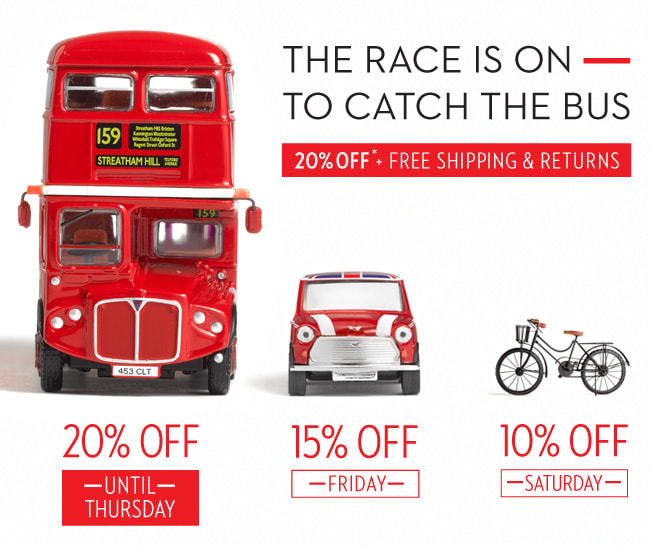
Increased discounts based on purchases
Unique promo codes are unique, meaning that they can be attached to individual users and purchase histories. Beyond personalizing the kind of products you’re making discount offers about, this creates three possibilities: multi-use discounts that increase in value, coupons linked to purchase histories and coupons with values that are linked to purchase totals.
Multi-use discounts
These kinds of discounts effectively work like loyalty cards, providing increasingly valuable promotions that are tied to purchase histories. Because the code is locked to an account, you don’t need to fear abuse of your promotional offering. These kinds of codes are great for building brand loyalty and are a form of gamification.
Purchase history
You can achieve very similar brand loyalty focused outcomes using single-use coupons that are triggered based on purchase histories. For example, you could provide shoppers with a 10% discount every time they spend a total of $150, and 20% off every time their total purchase history exceeds $500. If you want, you can go even more specific, linking discounts to specific products, multi-buys or value-based buys.
Purchase totals
Lastly, you can make coupons with values that vary based on how much is spent. This is something that can be achieved using traditional coupons, but is still a good trick to entice shoppers to spend more in order to ‘get a better deal’. For example, offering 20% off for purchases above $100, and 10% off for anything less.
Decreasing discounts based on purchases
You can flip increasing discounts on their head and make them decrease instead. This might not sound like a great way to entice customer loyalty, but you’d be surprised.
Single-use coupons are great, but you will encourage shoppers to make repeat purchases if they are able to apply a coupon multiple times. This creates a problem though. High-value promotions are more likely to attract attention and get used. However, they cut into your margins. It’s likely that you don’t want to offer someone 50% off on a bunch of items.
Decreasing coupons give you the best of both worlds. They allow you to grab attention with a high-value, one-time offer. They then keep that shopper engaged by allowing them to keep making discounted purchases. However, you keep your margins high by dropping that discount with every subsequent purchase.
Gamification of discounts
Gamification is what it sounds like — turning things into games. Unique promo codes allow you to do this by making it simple to create and issue coupons that are tied to the actions of individuals. This can easily augment any of the strategies discussed so far, particularly discounts based on purchase histories that increase in value the more you spend.
The real trick to gamification is to make the game clear to shoppers from the start. For example, buy one item of every clothing category and win a $100 voucher. Or get 15% off every time you buy a new category of item. However, if the rules don’t make sense, you’re less likely to engage prospects.
You can also tie gamification discounts to outreach strategies — offering discounts based on referring new customers. When partnered with the strategy of providing coupons to customers that they can hand out to their friends, this becomes a powerful tool able to turn your existing customer base into an extension of your marketing team.
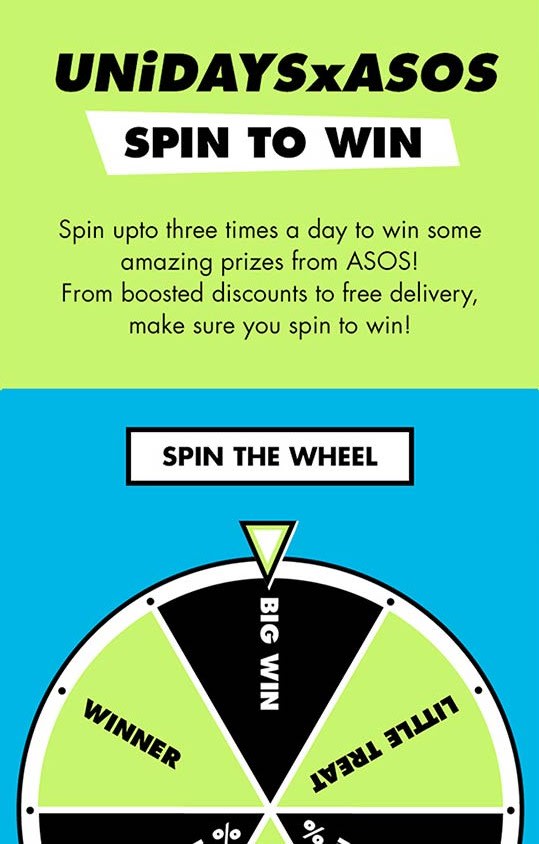
Create availability limits
Availability limits are another great way to motivate action. This is a common strategy in shopping cart abandonment emails that can be executed without a coupon at all — simply pointing out that there are ‘ONLY 3’ items left, etc.
Availability limits can act as another diminishing time limit. For example, offering the first 10 people to claim a discount that is 30% off, 20% for the next 10, and so on. Equally, you could just state that the coupon is only valid for the first 100 people to redeem it.
This is a great strategy to partner with amazing discounts. You are able to offer better deals because fewer people will redeem them. It also encourages immediate action, something that can be helpful if you need to move a particular product quickly — for example, at the end of a season.
Mystery rewards
A big part of creating a successful promo campaign is grabbing the attention of shoppers. Mystery creates questions that can be hard to turn your back on — compelling shoppers to click through and increasing the chance of driving sales.
Unique promo codes can be anything you want, and this creates the possibility of turning each promo code into a game of chance. Although we have advised being specific in your coupon title, particularly in emails, creating a sense of mystery can have the same effect for the opposite reason. However, you should be clear in the subject line that a “mystery prize” awaits.
You might offer a complete surprise: “Click to win your mystery discount.” What we like more, however, is a range of clearly stated outcomes: "Win 5% or 25% off everything.” That allows you to entice shoppers with a 25% discount, while taking a total of a 10% or 15% hit to total sales. Just make sure to not be too stingy with your payouts. The right promo code tool can make sure that you always hit an average discount overall.
This is a subcategory of gamification that you should consider. You can also align this with seasonal themes, like this great example below:
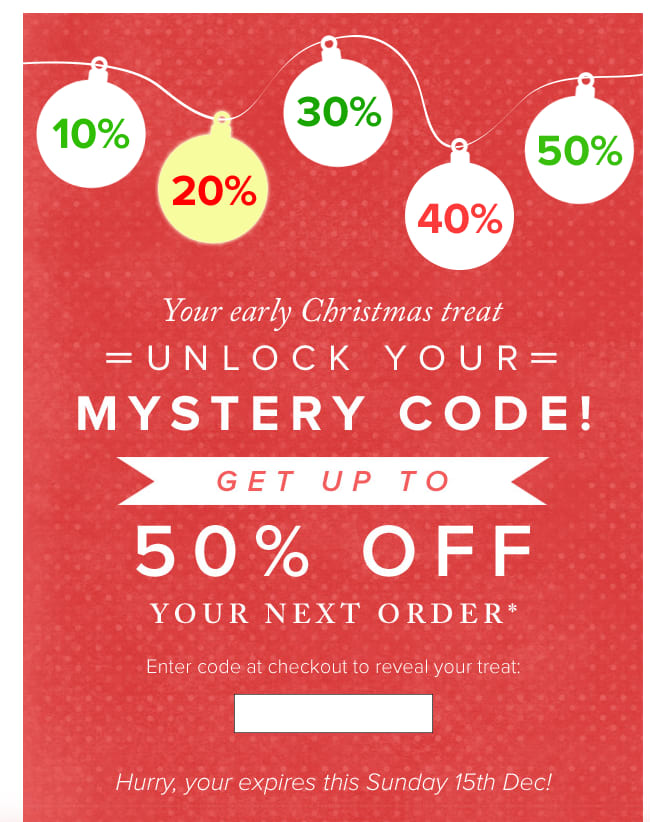
Gated content — Unique access
Coupons that open gates are an interesting reversal of standard promo strategies. Rather than offering a discount, you make the purchase itself conditional on having the coupon. This creates a sense of exclusivity around the item, making a compelling trigger to purchase. This works well for luxury items and is a strategy that can be deployed both to acquire new customers and reward existing customers.
A/B test promotions to specific segments:
A/B testing is an important element of making sure that you are doing the right thing. Unique promo codes make it easy to experiment. You could supply a “30% off” discount to one audience segment, and “buy one get one half off” promotions to another. If you track results, you will see what works best for your customers.
Next, try and segment your customers into different groups, and see which strategies work best for each. To do this effectively, you will need them to make accounts. However, most e-commerce sites encourage this to make processing payments easier.
Get creative and optimize how you use promo codes by recording outcomes and A/B testing what you do. Make sure that any unique promo code generator that you invest in is able to deliver those kinds of analytics. It’s key to your success using promo codes.
Automate your emails and promotions:
If you are going to have much success with any of these tailored strategies, you are going to need automation capabilities. If you attempt to manually craft and deliver unique promotions, you will rapidly run out of time, even if you do have the technology to produce single-use, unique promo codes.
When looking for technology that’s able to help you create unique promotions, make sure that you are equally investing in IT to automate those campaigns. The best promo generators bring automation capabilities to the table. Others are able to integrate with popular CRM tools. The best options can do both — delivering flexibility and power. We recommend finding a solution that fits into your campaign strategy.
This article, excerpted from 'The Ultimate Guide to Using Promo Codes in eCommerce Strategy,' was brought to you by Chris Giddins, Co-founder and CEO of Uniqodo. Uniqodo is a promotions engine helping e-commerce companies market and message to their audience more effectively using coupon and discount codes. Uniqodo offers advertisers truly controlled promotions, enabling new affiliate partnerships and giving advanced discounting capabilities to any e-commerce platform.




